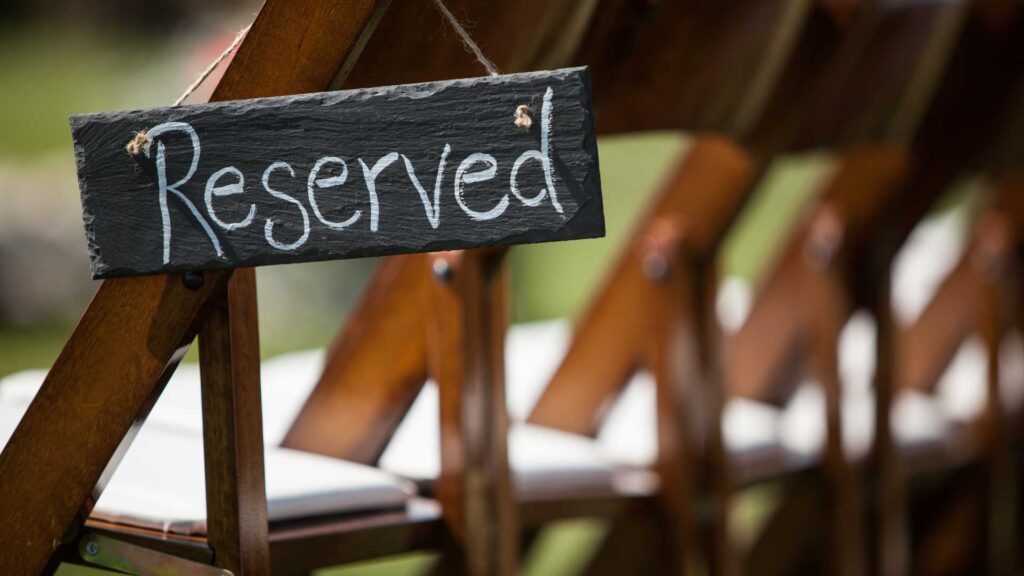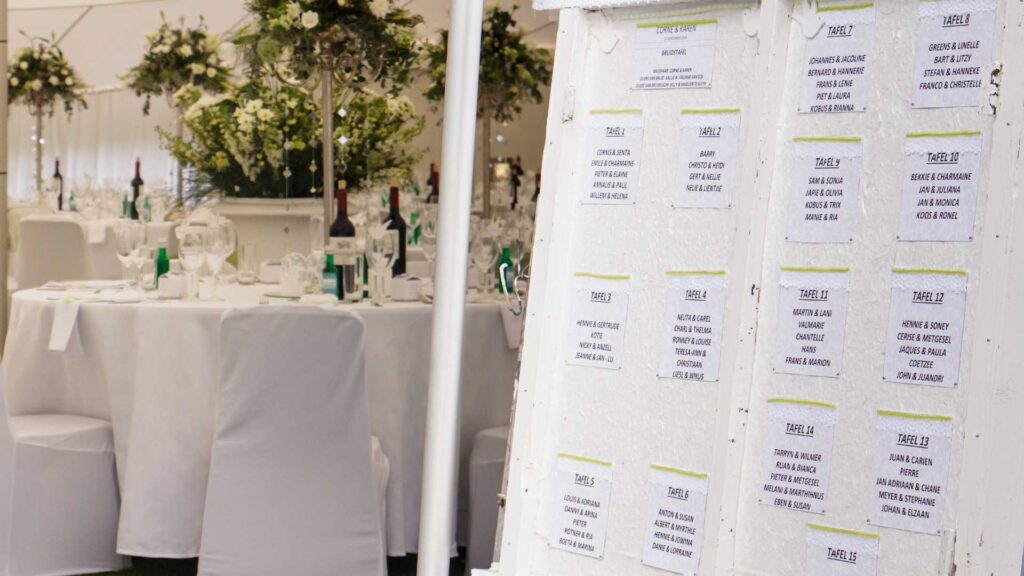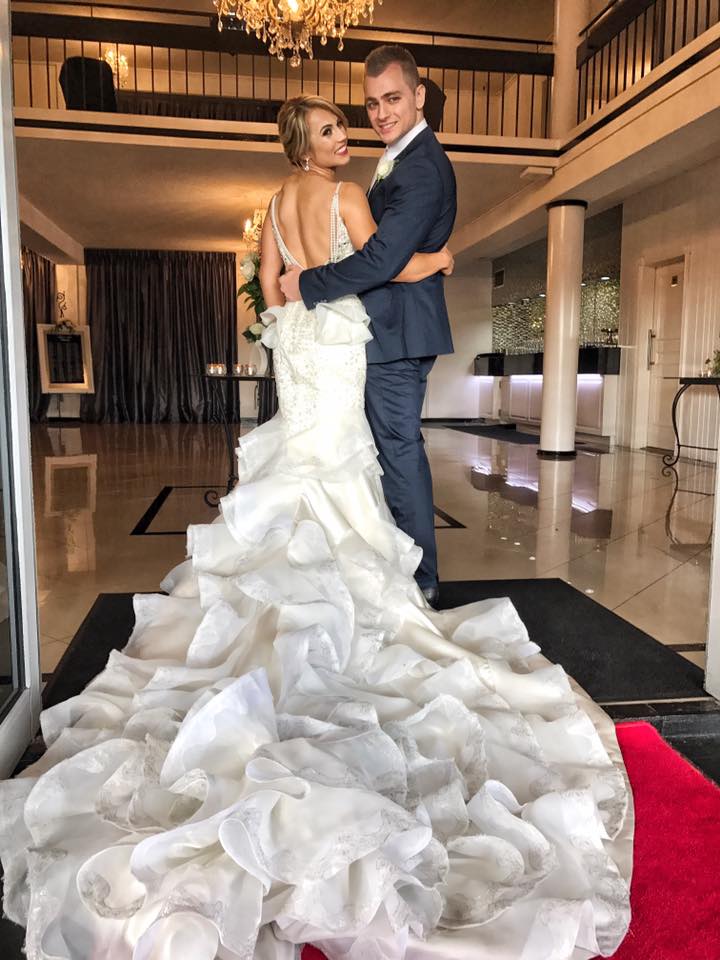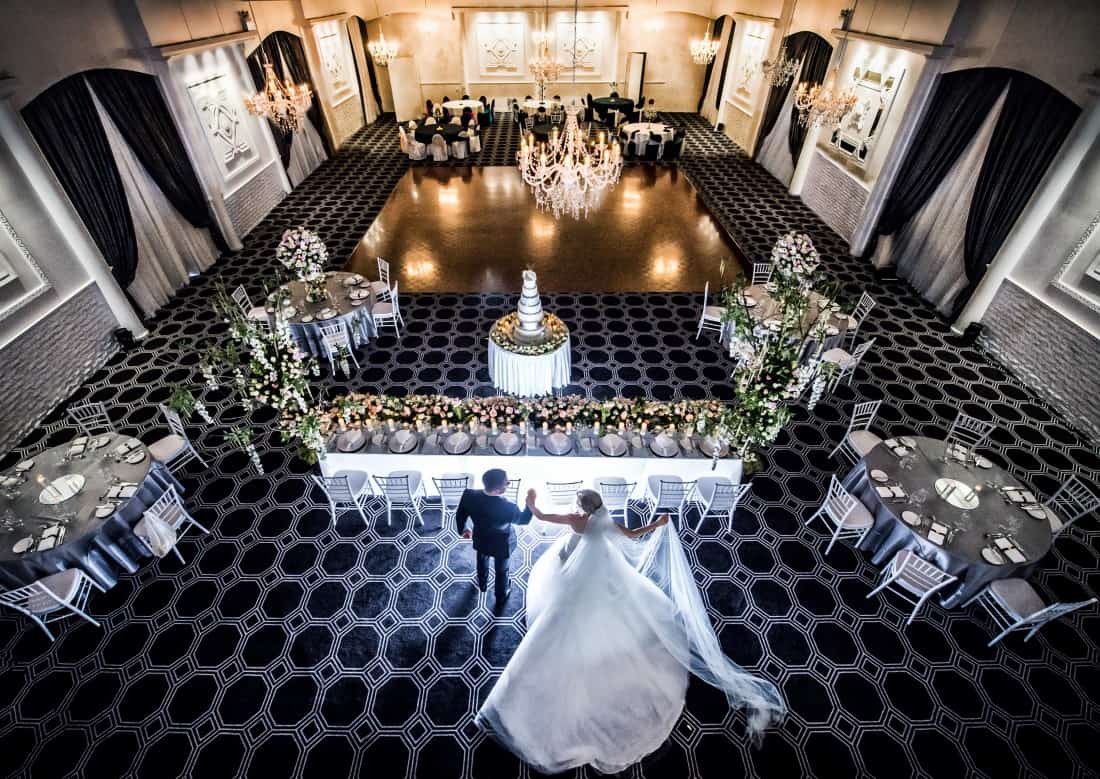When planning a wedding, one of the most important yet challenging tasks is creating a seating arrangement that ensures all your guests have a great time. A well-thought-out seating plan can make your reception flow smoothly, avoid confusion, and keep everyone comfortable. Here’s a comprehensive guide to help you navigate the complexities of wedding reception seating etiquette.
Let’s Get Straight to the Point
Planning a wedding reception seating arrangement involves:
- Choosing the right table shapes.
- Seating the wedding party and parents appropriately.
- Grouping guests by familiarity.
- Special arrangements for children and elderly guests are being considered.
Avoid singles-only tables, use online tools for creating seating charts, and ensure table assignments are clear. An official seating plan helps avoid confusion and ensures everyone feels comfortable, making your reception run smoothly.
Start With Table Shapes
Before you can start assigning seats, you need to decide on the shape and size of the tables. The number of guests each table can accommodate depends largely on its shape. The most common table shapes used at weddings are oval, square, rectangular, and round. Each shape has its benefits:
- Rectangular tables are ideal for long conversations and allow for easier cross-table communication.
- Round tables are the most popular as they offer more legroom and promote social interaction among guests.
Choosing the right table shape sets the foundation for your seating arrangement, ensuring guests are comfortable and can easily engage with those around them.
Seat The Wedding Party Together
The wedding party plays a significant role in your special day, so it is customary to sit them together at a head table. This table is usually positioned in a prime location in the reception area, often facing the rest of the guests. If you prefer a more intimate setting, you could opt for a sweetheart table for both of you and seat the wedding party nearby.
Consider seating the bridal party with their partners and close friends if you’re going with a head table. This arrangement acknowledges their support and lets them celebrate with you in a central position at the reception.
Plan Seating For Your Parents
Traditionally, the bride and groom’s parents and other close family members who are not part of the bridal party sit together. This allows them to share in the celebration with those closest to them. If your parents are divorced or there are other complex family dynamics, it’s important to consider this when arranging seating.
One way to avoid tension is to seat divorced parents at opposite ends of the table or across from each other at a square table. This way, everyone feels included without any awkwardness or discomfort.
Involve Your Parents In Seating Their Friends
Your parents will likely want to know where their friends are seated. Involving them in this part of the planning process gives them a sense of inclusion and ensures their guests feel comfortable. Ask your mum and future mother-in-law to help arrange the tables for their friends, allowing them to place their close companions together.
Group Guests By Familiarity
When it comes to seating guests, it’s helpful to start by grouping them by their relationship to you. Think about how well they know each other and their common interests. Mixing up guests to encourage new conversations is nice but ensures a balance. People feel more at ease when seated with at least a few familiar faces.
Consider their ages, interests, and cultural backgrounds when grouping your guests. Avoid seating guests together if any known tension or history might cause discomfort. This thoughtful approach helps create a harmonious and enjoyable atmosphere.
Consider A Children’s Table
Creating a children’s area is good if you expect several children at your reception. Please set up a table with games and activities to keep them entertained. However, it’s best to seat younger children with their parents rather than alone. This way, parents can watch them, and the kids won’t feel isolated.
If only a few children, like a ring bearer or flower girl, seating them with their parents is usually the best option. This ensures they feel included and can enjoy the day with their family.
Avoid A Singles-Only Table
While playing matchmaker by seating single guests together might seem tempting, it’s generally better to avoid setting up a singles-only table. Doing so can make some guests feel uncomfortable or singled out. Instead, single guests should be integrated into groups where they’ll feel comfortable and enjoy the company of couples and other singles. Always consider how each guest might feel about where they’re seated.
Keep The Venue Layout In Mind
When planning your seating arrangement, consider the layout of your venue. Important guests, such as your parents, grandparents, and close friends, should be seated in prime locations where they can see and hear everything. Elderly guests may prefer to sit a bit further from the dance floor, where it’s quieter, and they can enjoy the celebration comfortably.
Guests with mobility issues should be seated at tables that are easily accessible, such as those near the room’s perimeter or close to the dance floor. Younger guests, likely to be more energetic and involved in the festivities, might enjoy being closer to the DJ or band.
Create A Virtual Seating Chart
Technology can be a lifesaver when it comes to planning your seating arrangement. Online tools like WeddingWire, All Seated, and Wedding Mapmaker allow you to create a virtual seating chart, easily rearranging guests and visualising the layout. These platforms offer templates that can be customised to fit your venue’s dimensions, saving you time and effort.
If your venue is listed in one of these databases, you can choose it and start placing tables and chairs. This helps ensure your seating arrangement works well with the room’s flow.
Consider A Physical Seating Chart
For those who prefer a more hands-on approach, creating a physical seating chart can be a fun and interactive way to plan your reception. Use laminated sheets or a pegboard to arrange tables and seats, moving names around until you find the perfect combination. Writing guests’ names on Post-It notes allows for easy adjustments.
You can also sketch the room layout on a large chalkboard or use dry-erase markers to try different seating configurations. This tactile approach can be particularly helpful for visual planners.
Assign Tables, Not Seats
If you’re worried about overcomplicating things, consider assigning tables instead of specific seats. This approach allows guests to choose seats while ensuring everyone has a place. It also reduces the risk of confusion and helps guests settle in more quickly.
When assigning tables, group guests together who are likely to enjoy each other’s company. Even without assigned seats, it’s a good idea to designate areas for your VIP guests, such as family members and close friends, so they have a reserved spot.
Make Table Assignments Clear
Whatever method you choose, ensure that your table assignments are communicated to your guests. Place cards are a traditional option and can be styled creatively to match your wedding theme. Tent cards or envelope cards are popular choices and can be placed directly on the tables.
Alternatively, you can use a seating chart displayed at the entrance of your reception area. Listing guests’ names in alphabetical order rather than by table can make it easier for them to find their seats. A seating diagram with numbered seats and corresponding names can be particularly effective for longer tables.
The Importance Of An Official Seating Plan
While it might seem like an unnecessary formality, especially for smaller weddings, an official seating plan can significantly improve the flow of your reception. With a plan, guests might find themselves able to find seats, leading to clarity and potentially awkward situations.
If you’ve ever attended a wedding without a seating plan, you know how chaotic it can be as guests try to figure out where to sit, particularly during dinner. A well-thought-out seating arrangement helps avoid these issues, ensuring everyone feels welcome and knows where to go.
You might not need a detailed seating plan for smaller weddings, particularly those with fewer than 50 guests. Instead, consider using place cards for key tables, such as the head table, while allowing other guests to choose their seats.
Who Sits Where?
The couple typically sits at a sweetheart table in a central location at your reception, often facing their guests. Some couples prefer to sit at a table with the wedding party, while others opt for a separate table for the two.
If you’re following tradition, the best man typically sits on the bride’s left and the maid of honour on the groom’s right. Other bridal party members can be seated nearby with their partners. There are no strict rules here, so feel free to arrange the seating to best suit your celebration.
For family tables, the couple’s parents usually sit on opposite sides of a long table, along with other close relatives and special guests. If parents are divorced or there are other sensitive family dynamics, consider separate tables to ensure everyone is comfortable.
Seating For Singles And Couples
When seating single guests, avoid making them uncomfortable by creating a special table for singles. Instead, single guests should be mixed with couples and other singles with similar interests. This way, everyone can enjoy the reception in good company.
If you’re hoping to introduce certain guests to each other, you can do so subtly by seating them at the same table. However, be mindful of the dynamics to ensure everyone feels at ease.
Special Considerations For Seating Children
If your reception will include many children, consider setting up a designated children’s table with age-appropriate activities to keep them entertained. The kids can have fun while their parents enjoy the reception.
For smaller groups of children, such as the flower girl and ring bearer, seating them with their parents is usually the best option. This ensures they feel included and have their parents nearby for comfort.
Seating arrangements at a wedding reception can be challenging, but with some planning, you can create a setup that ensures everyone has a great time. From choosing the right table shapes to deciding who sits where, each decision contributes to the overall success of your event.
By following these tips, you’ll be well on your way to creating a seating plan that works for you and your guests, making your wedding reception a smooth and enjoyable experience for all.




